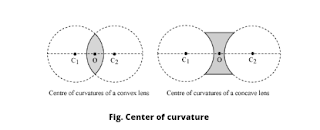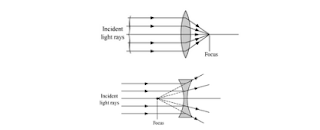Presbyopia: Generally, the focusing power of the eye lens decreases with age. The muscles near the lens lose their ability to change the focal length of the lens. The near point of the lens shifts farther from the eye. Because of this old people cannot see nearby objects. Sometimes people suffer from nearsightedness as well as farsightedness. In such a case bifocal lenses are required to correct the defect.
Nearsightedness: It is also called Myopia In this case, the eye can see nearby objects clearly but the distant objects appear indistinct. This means that the far point of the eye is not at infinity but shifts closer to the eye. In nearsightedness, the image of a distant object forms in front of the retina
There are two reasons for this defect.
1. The curvature of the cornea and the eye lens increases. The muscles near the lens can not relax so the converging
power of the lens remains large.
2. The eyeball elongates so that the distance between the lens and the retina increases. This defect can be corrected by using spectacles with concave lenses of proper focal length. The focal length of the concave lens is negative, so a lens with negative power is required for correcting nearsightedness.
Question 2. Draw a figure explaining various terms related to a lens.
Answer :
1. Centre of curvature (C): The centers of spheres whose parts form surfaces of the lenses are called centers of curvature of the lenses. A lens with both surfaces spherical has two centers of curvature C1 and C2
2. Radius of curvature (R): The radii (R1 and R2) of the spheres whose parts form surfaces of the lenses are called the radii of curvature of the lens.
3. Principal axis: The imaginary line passing through both centers of curvature is called the principal axis of the lens.
4. Optical center (O): The point inside a lens on the principal axis, through which light rays pass without changing their path is called the optical center of a lens. In rays P1, Q1, P2, and Q2 passing through O are going along a straight line. Thus O is the optical center of the lens.
5. Focal length: The distance between the optical center and the principal focus of a lens is called its focal length.
Question 3. At which position will you keep an object in front of a convex lens to get a real image of the same size as
the object? Draw a figure.
Answer: At 2F1
Question 4. Give scientific reasons:
a. Simple microscope is used for watch repairs.
Answer: Simple microscope has a convex lens that can produce 20 times larger as well as erect images of an object. This means the magnifying power of the microscope is very high. Thus, simple microscopes are used by watchmakers to see the small parts and screws of the watch while repairing it.
b. One can sense colors only in bright light.
Answer: The cells present on the retina and responsible for color vision are known as cone cells. These cells become active only under bright light and remain inactive under dark. Thus, we can sense only in bright light.
c. We can not see an object kept at a distance less than 25 cm from the eye.
Answer: When we try to see a nearby object, the eye lens becomes more rounded and its focal length decreases. Then a clear image of the object is formed on the retina of the eye. The focal length of the eye lens cannot be decreased beyond some limit. Therefore we cannot see an object kept at a distance less than 25 cm from the eye.
Question 5. Explain the working of an astronomical telescope using the refraction of light.
Answer:: To view distant objects clearly in their magnified form, the telescope is used and the telescopes used to see astronomical sources such as the stars and the planets are known as astronomical telescopes.
There are two types of telescopes :
1. Refracting telescope, which uses lenses and
2. Reflecting telescope that uses mirrors as well as lenses
Working: In both telescopes, the image formed by the objective is the object in the eyepiece, which produces the real image. Objective lenses are of large diameter and larger focal length so that the maximum amount of light coming from a distant object can be collected. However, the eyepiece is of smaller size with a lesser focal length. Also, both lenses fit inside a metallic tube in such a way that the distance between them can be changed. Meanwhile, the principal axes of both lenses are on the same straight line. Generally, by using the same objective with different eyepieces, it is possible to get images with different magnifications.
Question 6. Distinguish between:
a. Farsightedness and Nearsightedness
Answer :
| Farsightedness | Nearsightedness |
|---|
| It is also called myopia | It is also called hypermetropia |
In these defect, the human eye is unable to
see nearby objects clearly | In these defect, the human eye is unable to
see distant objects clearly |
In these defects the image of a distant object is
formed in front of the retina | In these defects the image of a nearby object
would be formed behind the retina |
| This defect can be corrected by using a concave lens | This defect can be corrected
by using a convex lens |
b. Concave lens and Convex Lens
Answer :
| Concave lens | Convex lens |
|---|
| A concave lens has its surfaces curved inwards | Convex lens has its surfaces puffed up outwards |
| It is thicker at the edges than in the middle | It is thicker in the middle than at the edges |
| It can form only a virtual image | It can form only a real image as well as virtual images |
| It can form only a diminished image | It can form a magnified diminished or the same sized image depending on the position of the object |
Question 7. What is the function of the iris and the muscles connected to the lens in
human eye?
Answer: Function of Iris: The iris is a muscular diaphragm that controls the size of the pupil, which in turn controls the amount of light entering the eye. It also gives color to the eye.
The function of ciliary muscles: The eye lens is held in position by the ciliary muscles. The focal length of the eye lens is adjusted by the expansion and contraction of the ciliary muscles.
Question 8: Solve the following examples.
i. Doctor has prescribed a lens having power +1.5 D. What will be the focal length of the lens? What is the type of the lens and what must be the defect of vision?
Answer: Given
Power of lens, $P=+1.5 mathrm{D}$ Now, focal length of lens, $f=frac{1}{P}=+frac{1}{1.5}=+0.67 mathrm{~m}$
Since the focal length is positive, the lens prescribed for correction is a convex lens. Thus, the defect of vision is farsightedness or hypermetropia.
ii. 5 cm high object is placed at a distance of 25 cm from a converging lens of a focal length of 10 cm. Determine the position, size, and type of the image.
Answer: Given
Height of object, $h_{0}=5 mathrm{~cm}$ Object distance, $u=-25 mathrm{~cm}$ Since the lens is converging, thus it is a convex lens. Focal length of the lens, $f=10 mathrm{~cm}$ Using lens formula, $frac{1}{v}-frac{1}{u}=frac{1}{f}$
$Rightarrow frac{1}{v}=frac{1}{10}+frac{1}{-25}=frac{3}{50}$
$Rightarrow v=frac{50}{3}=16.7 mathrm{~cm}$
Thus, the image is formed $16.7 mathrm{~cm}$ right of the lens.
Now, we know $frac{v}{u}=frac{h_{mathrm{i}}}{h_{mathrm{o}}}$
$Rightarrow h_{mathrm{i}}=frac{50}{3 times-25} times 5=frac{10}{3}=-3.3 mathrm{~cm}$
The size of the image is 3.3 cm .negative sign shows that the image formed is real and inverted. Hence the image formed is real and inverted and diminished.
iii. Three lenses having power 2, 2.5, and 1.7 D are kept touching in a row. What is the total power of the lens combination?
Answer: Given
$P_{1}=2 mathrm{D}, P_{2}=2.5 mathrm{D}, P_{3}=1.7 mathrm{D}$
Let the total power of the lens combination be $P$. Thus, $P=P_{1}+P_{2}+P_{3}=2+2.5+1.7$
$=6.6 mathrm{D}$
iv. An object kept 60 cm from a lens gives a virtual image 20 cm in front of the lens. What is the focal length of the lens? Is it a converging lens or diverging lens?
Answer: Given
Object distance, $u=-60 mathrm{~cm}$ Image distance, $v=-20 mathrm{~cm}$ Using lens formula, $frac{1}{v}-frac{1}{u}=frac{1}{f}$
$Rightarrow frac{1}{f}=frac{1}{-20}-frac{1}{-60}=-frac{1}{30}$
$Rightarrow f=-30 mathrm{~cm}$
Since the focal length is negative, the lens is a diverging lens or a concave lens.










